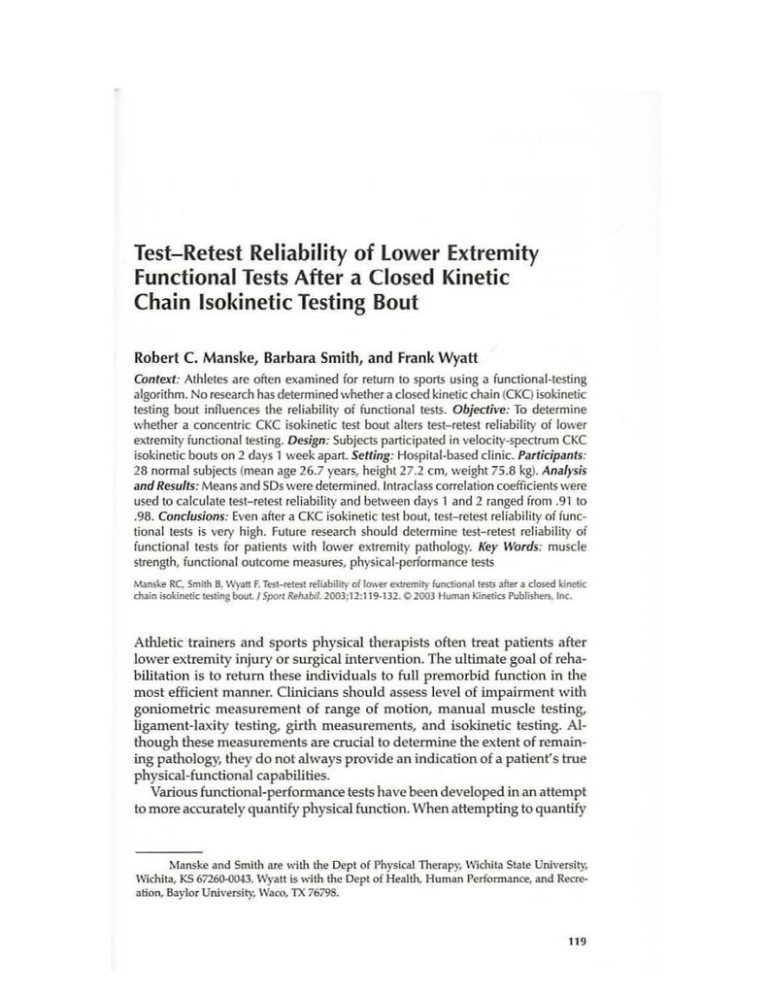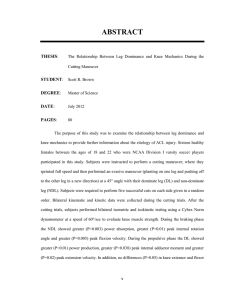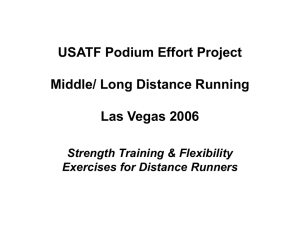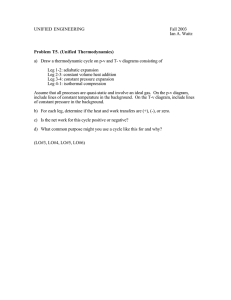Document 14751573
advertisement

Test-Retest Reliability of Lower Extremity
Functional Tests After a Closed Kinetic
Chain Isokinetic Testing Bout
Barbara
Robert C. Manske, Ba
rbara Smith, and
a nd Frank Wyatt
Alhletcs are often examined for return [0
Context:
Context: Athletes
to sports using a functional
functional-testing
-testing
netic chain «
(KQ isokinetic
algorithm.
algo
rithm. No research has determined whether a closed
d osed ki
kinetic
(CKq
testing
tesling bout influences the reliability of functional tests. Objective:
Objective: To determine
test- retest reliability of lower
whether a concentric eKe isokinetic test bout alters test-retest
fun ctional testing.
testing. Design:
Design.- Subjects participated in velocity-spectrum eKe
extremity functional
isokinetic bouts on 2 days 1 week apart. Setting:
Sening: Hospital.based
Hospital.bas(!(f clinic. Participanls:
Participants:
28 normal subjects (mean age 26.7 years, height 27.2 em,
e m, weight 75.8 kg). Analysis
5Ds were determined. Intraclass
Intradass
and Results: Means and SDs
In!radass correlation coefficients were
relliabili
iabili ty and between da ys 1 and
used to calculate test-retest re
liability
a nd 2 ranged
ra nged from .91
.9 1 to
.98. Conclusions: Even after a CKe
retest relia
bility of fu
ncCKC isokinetic test bout,
test-retest
reliability
funcbout. testtional tesls
tests is very
should
retest
\'ery high. Future research shou
ld determine testtest-retest
re test rel
reliability
iability of
fu nctiona
nctionall tests for patients with lower
lowe r extremity pathology. Key Words:
\..\'ords: muscle
strength. functional
functional outcome measures, physical-performance tesls
strength,
tests
"'l.lnske
RC,
Smith
B, W)'an
Wran
F., T
Tesl-n~t"t
'eti~biliry
of lowe<
tc........et
er extremiry
extremity fuoctional
functioNl 1l'SU
test5
dO$Cd
.......
,\ unske
lI5ke R
C, Smi!h
Smilh B.
\'I)'lIR F
TCSHet~
esI-retesl feli3biliry
reH
ab,l,ry oi
kr.·
e).1fl'miry
functioN!
~t5U after
~fler a
~ d<:Md
d~ kinetic
main isokinetic
bouL
I 5porll/8l;Jbil_
Spot!
Rela!);i. 1003;11:119.1)2.
l00J
;12:ll'l.1]2. 0
Q 200]
~ing bou1.
1
5fKN~ Reubi/.
200] ;12:119.132.
2003 Hum.m
Kinmu Puhlishers,
Publiw.",
Ioc..
chain
i.m' neti.:;: testing
bout. J
Human ",....nG
Kinel''''
Publi~, Inc.
,,,,,,,,nett.:;:
Athletic trainers
traine rs and sports physical therapists ooften
ften
ft
en treat patients after
lower extremity inju
injury
ry or surgical
surg ical intervention.
intervention . The ultimate goal ooff rehabilitation is to return these individuals to full premorbid function in the
most efficient manner. Clinicians should assess level of impairment with
w ith
goniomelric
muscle
goniomel:ric measurement of range of motion,
goniometric
mo tion, man
manual
ual mu
scle testing,
testing.
ligament-laxity testing.
testing, girth measurements, and isokinetic testing
testing.. Although these measu rements are crucial to ddetermine
etermine the extent of
o f remaining pathology, they d o not always provide an indication of a patient's true
physical-functional capabilities.
functional -performance tests have been developed in an attempt
Various functional-perfornlance
functional-performance
to more accurately qu
10
quantify
function.
antify physical function
functi on.. When attempting to quantify
Physical Therapy, Wichita
State University,
Manske and Smith are with the Dept of I'h)'sical
I'hysical
Wichi ta Slate
Stale
Universi t}.
wichit'!, KS 6n6()...{)04J.
672h()...004J.
with
th the Dept of Health. Human Performance, and RecreWichita,
67261J...OO43. Wyatt is wi
\\ith
\Vacu, TX 76798.
Waco,
76798.
ation,. Baylor University,
Universi ty, Waro,
'"
119
120
Manske, Smith,
Smilh, and Wyatt
\<Vyan
\oVyan
O\'lanskc,
lower
li mb impairment,
impairment. variables
lling, crepitus,
crepitu
crepi tu s,
lowe r limb
vari ables such
s uch as pain, swe
sswelling,
welling,
neuromuscular coordina
coordination,
tion, muscle strength, muscle endurance, and joint
stability
ty play important roles. 1 Functional testing requires that
thai the patient
stabili
perform activities that closely simulate a given sport or recreational activfunctional
onal
ity. In addition to a variety of stresses across the lower limb, functi
g iven
testing assesses whether the patient is mentally ready to retum to a given
Functional-testing
me thods should be fast
nal-testing methods
fa st and easy to perform
activity. Functio
ta ff oorr training,l
training/ and be sport-specific
in any
a ny setting, require minimal ssta
training,!
in nature.
na ture.
repea tctional test's reliability is essential to ensure accuracy and repeatA fun ctional
ability.
Reliability
is
the
dependability,
reprOducibility,
and
repeatability
Reliabili
ability
ty
reproducibility,
repea tability of
abili ty. Reli
3
a given measurement instrument.
instrument.] Potential problems can be managed by
implementing a standardized protocol w ith precise instructions and dear
clear
operational
opera tional definitions.
defutitions.
deve1oped
algorithm (FfA)
(FTA) as a method to
Davies4-l
developed a functional-testing algOrithm
Davies""'developed
Davies""
assess a patient in a systematic manner and to establish the functional
func tional progression of exercise and testing during the rehabilitative process. In the
ITA a sequence of tests must be passed before the patient can progress
FTA's first
safely to the next level. Basic tests and measurements form the ITA's
no t limited to palpation, range-of-motion teststage. These include but are not
manual muscle testing, flexibility
fl exibility testing, special tests, kinesthesia /
ing, manual
measurements
proprioception tests, and KT-lOOO
KT-1000 testing. If results of these measu
rements
demonstrate less than a 10% difference between the involved and uninvolved extremities, the patient is progressed to the next ie\·el
level of
o f testing.
The second ITA level includes both closed and open kinetic chain isokinetic
testing. If results of these measurements
measu rements on the involved extremity
ex tremity are
within 10% of those on the uninvolved extremity, the patient is progressed
to the next level of testing. It is at this point that the patient undergoes
fu nctional
ua l has not full
fully
individua
y passed the ITA,
FrA, he
various functi
functional
onal tests. If an individ
return to rehabilitation and concentrate on areas in which
wh ich he or
or she will retum
she faltered du
ring the test. For example, if an individual has passed the
during
firs
measu res and the isokinetic lest
fa ils
il s the
firstt phase of basic tests and measures
test yet fail
single-leg hop functional tests, rehabilitation would emphasize single-leg
sing le-leg
power-type exerdses.
exercises. After appropriate rehabilitation, the athlete
will then
athIetewili
again be progressed through the entire ITA to ensure that he or she is at
least at the same level as during previous testing.
ctional
Numerous
test- retest reliability ooff fun
functi
onal
' umerous authors have measured test-retest
1
5In
all
o
f
those
studies,
the
subjects
performed
tests with normal subjects.<).u
subjects.<)'
pe rformed
subjects.9-U In of
foUowed by the given functionallests.
fu nctional tests.
Theore tically this
warm-u p followed
a brief warm-up
functional
tests . Theoretically
in most clinical situations an isokinetic test o
orr tests
could be problematic. In
performe d before functiona
funnctional
ctiona l testing. Using the ITA for paare generally performed
fu
isokinetic
pertient progression, patients always undergo iso
kinetic testing before pe
rtests. The purpose of this study is to deterde terforming one or more functional tests.
onal testing alters
functional
mine whether a set of isokinetic testing bouts before functi
functional
test- retest reliability of
onal tests for the lower extremity.
test-retest
o f the functi
extrentity.
Tes15
Lower Extremity
utrcmity Functional Tesl.'i
Test.'i
121
Methods
Subjects
Subj
ects
A sample of 28 healthy participants (mean age 26.7 ± 5.2 years, range 19cm, range 24.4-29.9; mean weight 75.8 ± 14.9 kg.
kg,
37; mean height 27.2 ± 1.6 em,
re<: nlitpd
range 47.7-107.1)wa5 nYTl
rPNllitpd
litpd thmugh
through a university physical therapy
therapyedueduorth opedic physical
cational program and a local sports and orthopedic
ph}'sical therapy outpatient
patien t clinic. Participants were evaluated for lower extremity pathology
through a self-reported health-history questionnaire and a physical examiprincipa l investigator to assess for knee instability
instabili ty via liganation by the principal
testing, and proprioceptive ability was tested with sing
le-Iegsingle-legmentous testing.
stance testing. Participants had to be able to hold a single-leg stance for 30
3D
seconds without loss of balance to be included in the study. Any particiank1e injury (within the preceding 9 months), past
pant with acute knee or ankle
procedure(s)
surgical procedure{s}
procedure(s} oonn one or both
bo th knees, ligamentous instabili ty, or loss
surgical
of proprioceptive abili
ability
ty found on exam was excluded from the study. Participants received an explanation of risks, benefits, and procedures and
uni versity's and medical
signed an informed consent approved by the university's
center's
center 's institutional review boards.
boards.
Procedures
A test-retest
test- retest design was used
used,, with 7 days beh
behveen
veen testing sessions. Parlly changing
substantially
ticipants were asked to refrain from increasing or substantia
fa ctors that couJd
their present exercise routine to control for outside factors
could conconsistent. In additaminate the results. lime of day for testing was kept consistent.
tion,
tion,. the participants were asked to keep personal habits (eg.
(eg, sleep, diet)
sh orts and, to rule
between testing periods. Participants wore shorts
consistent beh\'een
oout
ut footwear
fooh\'ear
o f any difference in scores, they were asked to
foo
hvear as a cause of
func tional-testing surface
athle tic shoes for all tests. The functional-testing
wear
wea r the same athletic
was all low-pile
onal tests
l ow~ pile carpet glued onto a concrete floor.
fl oor. The functi
fun
hlOctional
ctional
used were chosen based on their prevalence in the orthopedic and sportsd ominance was determined by asking participants
medidne
medicine literature. Leg dominance
which leg they would be most comfortable kicking a ball with. All testing
was perfo
performed
rmed in a nonrandomized order, beginning with the isokinetic
m ore closely simufun ctional
onal tests.
tests. This was done to more
mace
bouts, followed
follo wed by the functi
late acrnal
sports
rts and orthopedic physical theraactual clinical conditions. Three spo
pists, each with a minimum of 6 years of clinical experience, performed all
data collection.
Instrumentation
(Loredan BicThe Lido Linea closed kinetic chain isokinetic d ynamometer (loredan
Biomechanical, West Sacramento, Calif) was used to test the leg extensors betesting. The Lido Linea was calibrated per the instruction
fore fun ctional testing.
havp
hPpn deJ;cribed
de!';cribed previously.16
previously.16
manu
al. Calibration procedu.res
procedmes h,wp
manual.
h;1 V P }w.pn
})f'.pn
deRcribed
...."an,ke, Smith,
Smi1h, and Wyiltt
W)'iltt
122 ""anske,
Warm-Up
Each participant performed a warm-up
warm-u p before each session, consisting of 5
minutes ooff exercise on a stationary bicycle at a self-selected, submaximal
submaxirnal
intensity.
Iso kinetic
kin etic Testing
Each participant was positioned semirecumbent in the Linea's leg-press
chair and stabilized by a lap belt (Figure 1).
1). With the knees fully
full y extended,
the participant's hips were in approximately 70°
70 of flexion.
flexion . The linear
lineae range
of motion WilS
was set so that the knees moved hom
h om approximately 90°
90 0 to 5°
5 0 of
knee flexion
fl exion during the complete leg-press stroke. A popliteal pad was
placed behind the knees to preven
preventt hyperextension
hyperextension.. The range-of-motion
stops and the popliteal pad's position were recorded at the first session
and replicated during the second test session.
session. Participants were allowed to
grasp the system's handles during testing.
testing.
Before each isokinetic bout,
bOllt, the participant performed an isokinetic
warm-up of 3 gradient, submaximal repetitions, plus 1 maxim
maximal
al repetition
at each test velodty.
velocity. Each participant performed the same isokinetic bouts,
bOllts,
0
Figure 1
Semirecumbent position in lido
l ido linea
linea..
lower
Lower Ext
Exlremity
Extremity
remity FunctiorJal Tests 123
which consisted of 3 bbilateral
ilateral coupled leg-press sets followed by 3 bilateral
Lido
o Linea is
reciprocal leg-press sets. A bilateral coupled leg press on the Lid
defined as a complete leg-press stroke from the flexed to the extended powith
ith both extremities
extremi ties in unison. A bilateral reciprocal leg press is
sition w
flexed -knee to the extended
defined asa
as a complete leg-press stroke from the flexed-knee
position for each limb in direct succession. Each isokinetic bout consisted
velocity spectrum of
o f isokinetic
of 6 repetitions at 3 different velocities. A velocity
leg presses was performed in the concentric mode, consisting of slow (25.4
cm / s), medium (50.8 em / s), and fast
fa st (76.2 an
em / s) velocities. Participants
em
were instructed to perform
p erform 6 successive maximal volitional concentric
repetition s at each velocity. Strong verbal encouragement was
isokinetic repetitions
provided in a consis
consistent
tent manner to elicit maximal effort. Participants were
also given visual
vis ual feedback of their perfonnance
performance during
drning the exercise sesfast
st velocity,
sion.
sion. The exercise bout progressed from slow to medium to fa
which is common in clinical isokinetic testing . Efforts were separated by
30-second rest periods.
At the conclusion of the isokinetic bouts, each participant performed
perfonned
light quadriceps and h amstring stretching for up to 3 minutes
minu tes.. The cooldown was followed by the functiona
functional-testing
l-testing sequence
sequence.. A brief cool-down
was performed immediately after the isokinetic test, again to more
m ore closely
conditions.. During the actual FTA it generally takes sevsimulate clinical conditions
outt results
resul ts of the isokinetic test to determine whether
eral minutes to print ou
an individual has adequate strength to continue tlu
through
ough the testing procedures.
d ures.
Functional Testing
After the
th e closed
dosed kinetic chain isokinetic bouts, each
eacll pparticipant
articipant performed
follow ing functional
function
al tests: 2-legged vertical jump, single-leg
single- leg vertical
the following
fun ctional
jump, 2-legged jump for ddistance,
istance, single-leg hop, and timed 6-m sing
single-leg
le-leg
perfonned in the same sequencc.
sequen
sequence.
ce. Again, this
hop. Functional tests were all performed
u sed to ma
more
rc closely replicate the FTA described previously.
sequence was used
The fun ctional tests are progressed sequentially w
with
ith increasing
increasin g complexTluee waml-up
warm-up trials
tria ls were allowed for each functi
fun
functional
ctional
onal tes
testt to enable
ity. Three
the participants to gain some
som e familiarity with the actions requ
required
ired and to
ensure competence and understanding of test instructions. Each participartidpant performed 3 attempts of each test and was asked to give maximal
effort for each attempt.
attempt. A 1-minute
l -minute rest period w
was
as allowed
aUowed between
behveen tests,
and up to 30 seconds rest were given as needed between the 3 jumps. Upwas
as restricted as mudl
much as possible. After
Afte r comcom per extremity movement w
perfonned a cool-d
cool-down
own by riding a
pleting fun
functional
ctional testing, participants performed
bicycle
cle and l/ or stretching .
stationary bicy
Vertical Jump.
Jump. The vertical ju
jump
mp is commonly used
u sed in exercise physiollower
er extremity
extrem ity power. It is generally accepted
accep ted that a large
ogy to measure low
amount
amOlUlt of error can be generated by u sing traditional chalk or tape methamOlmt
ods of assessing vertical jump, so we used the Vertec
Vertecjump
Vertecj
jump
ump apparatus (Sports
124
Ma
Man~ke,
nske, Smith, and Wyatt
\¥ yatt
Imports, Inc, Columbus, Ohio). A
A standing
s tand ing baseline-read
baseline-reachl measurement
meas urement
was initially performed with each participant standing flatfooted and reaching as high as possible w
with
ith the right and then the left upper extremity.
Then the participant was asked to jump as high as possible and to reach
ips ilateral upper extremity
e xtremity to ddisplace
isplace a movable plastic vane of
w ith the ipsilateral
D.S-in increments. Countennovements with the upper extremities were uused
O.5--in
sed
during this test
tes t because reaching is part of the testing procedure to obtain
meas tuement.
urement. The
Th e standing basel
baseline
ine reach was
w as subtracted
sub tracted from the total
a measurement.
vertical-jump score to obtain the distance
d is ta nce jumped. Measurements
Meas tuements
urements were
made bilaterally
bilate rally and unilaterally.
JUIIIP
Jump alld Hop Tests . The 2-legged-jump
2-legged -jump test
tes t and the single-leg-hop
sing le-leg -hop test
single-leg
performed
d in a similar
s im ila r manner.
manne r. A standing
s tanding long-jump m at
a t (SBP,
w ere performe
Toronto, Canada) composed of a durable rubber material was u sed for
measuring
h ops. This m
mat
a t has a standardized starting p osition
mea suring jumps and hops.
and
o f 50-320 cm
em.. Participants stood
s tood with
an
d enables measurement of jumps of
----
-- ..
. --• - - .....
.---
.~
Figure 2
Double-leg jump
j ump for distance.
distance.
---
lower Exlremity
Extremity Fundional
Functional Tests
Figure 3
125
Single-leg hop for distance.
the front
ITont of their shoes behind the starting mark with hands
hand s on hips and
knees bent. They then jum
jumped
ped or hopped
h opped (2-legged oorr single-leg; Figures 2
with
wiith
th bent knee(s) to help
and
an d 3) as far horizontally as possible, landing w
decrease the risk of knee injury. The spot
sp ot where the heel of the more postep osterior shoe landed was marked and used as the jump distance.
distan ce. To qualify for
a legitimate
legi timate jump, a participant had to land without falling down
d own or taking
land ing,
a step. After landi
landing,
ng, this pposition
osition had to be held for
fo r at least 2 seconds. A
fa iled jump included loss ooff balance, touching the (Joor
floor
(foor w
with
ith the contralatcon trala tfailed
eral upper or lower extremity (during
(dilling single-leg hop), or an additional short
hop after landing. The mean distance of 3 maximal attempts of each test
was recorded.
recorded .
During
Dilling the single-leg hop,
h op, participants hopped using the nondominant
leg first, then the dominant leg. Once again, as with the 2-legged
2-1egged jump test,
momenturn w
with
ith the
they held their hands on their hips to avoid gaining momentum
arms. They then bent their
th eir knees and hopped as far forward
fOD\'ard as possible,
12& .\1anske,
Manske, Smith, and Wyd
Wyatttt
Figure 4 Single-leg 6-m
6·m
limed hop.
b·m timed
this time landing on the contralateral
extremity_The distance
con traJateral extremity.
d istance from the startstarling mark to the heel of the landing leg was measured. Each participant
partidpant had
h ad
to land without losing balance and w ithout relying on the other foot or
uup
upper
per extremity to aid in landing.
pper
6' //1 Timcd
Timed
Sillgle-Leg 6-m
Tim ed Hop.
Hop. The single-leg 6-m
6-01 timed hop began at the
same spot
h op tests. Participants used
s pot as the single- and 2-legged jump / hop
large, forceful Sing
sing le-leg hopping
6-m distance (Figure
h opping motions across the 6-01
4). A standard manual stopwatch
stopw atch was used
u sed to time each trial to the nearest
extTcmity,
cxtTc.m.ity, with
w ith
0.01 second . Three trials were performed
perfonned with
w ith each lower extremity,
fir st, then the dominant leg.
nondom inant leg tested first,
the nondominant
Data Analysis
Statistical analysis was performed using
u sing Statistical Package for Social Scilli). Analysis included standard
escrip1lI).
stand ard d
descripences (SPSS, version 9.0, Chicago, ill).
tive information (eg, mean, SO),
ti\'e
SD), as weU
well as correlation coefficients for eadl
each
functional
functional test. The means of day 1 and day 2 test scores were used to
determine inrradass
intradass correlation coefficients
coeffjdents (ICC!.J
(I C~ I )' The alpha level for
fo r all
all
(ICCl.J
aU
tests was set at
al :S.05.
~.05.
lower Ex1remil)'
Ex1remity Functional
Exlremil)'
Fundional Tests 127
117
Results
Res ults
Descriptive statistics for each functional test are shown in Table 1. The ICes
for the functi
functional
fun ctional
onal tests ranged from .91 to .98 (Table 2).
Comments
Comme
nts
Reli ability of any functional test is a prerequisite to its use
Reliability
u se in a clinical
stu d y has
h as examined the effect that a closed
d osed kinetic chain
cl
setting. To date no study
isokinetic test might hhave
ave on the tes
test-retest
testt-retest
retest reliability
reliabili ty of
o f functional
fun
functiona
ctionall tests.
Table
Tab
Tabllee 1 Means, Standard
Stand ard Deviations,
Deviatio ns, and Ranges
of Fun
Functional-Test
ctiona l-Test Scores·
Scores·
Mean
SD
Range
10.9
Vertical jump, dominant leg (em)
42 .7
2 7.4
8.4
227.2-64
7.2 -64 .8
,17.0-44.5
7.0-44.5
Vertical jump, nondominant leg (em)
331.5
1.5
lOA
10.4
17.8-57.7
17.8-5
7.7
ju mp, bilateral (em)
2-legged jump,
&2.1
1162.1
26.7
4.0
110.5 -22
- 224.0
Single-leg hop, dominant leg (em)
126.5
221.6
1.6
88.
88.11-- 185.4
hop,
Single-leg ho
p, nondomina
nondomi nanntt leg (em)
12 7.8
127.8
28.2
86.4 - T
' 88.0
Vertical jump, bi lateral (em)
(5)
Single-leg timed 6-m hop, dominant leg (s)
2.1
(5)
Single-leg timed 6-m hop, nondominant leg (s)
2 .1
2.1
0.36
0.42
·s
'B indicates
indicales bila1eral;
bilaleral:
bila1Cral; Dl,
Dl. do
domi
minant
nant
nantlcg;
leg; and NDL, nondominant
nondom
nondominMl1
inant leg.
leg.
Tabl
Tablee 2
Functional-Test
Fun
ctional-Test Test-Retest
Test- Retest Reliability
Rel iability
Fun ctionalles!
ctional lest
ICC
Ve
Vertical
rt ical jump, bilateral
Single-leg timed hop, dominant leg
.9.
.98
.9'
.9B
.9B
.91
.96
.97
.92
Single-leg timed hop, nondominantleg
nondominant leg
.96
.9&
Vertica
Verticall jump, unilateral, dominant leg
Vertical jump, unilateral, nondominant leg
2-legged
2-leggcd hop for distance, dominant leg
Single-leg hop for distance, dominant leg
Single-leg hop for distance, nondominant leg
1.7-2 .9
1.49-3.33
128
d Wyatt
Manske, Smith,
Smith.
and
128 f..'lanske,
Smith, an
Wyan
The purpose of this study
study was to detennine
dosed kinetic chain
determine whether a closed
nly
isokinetic test would
commonly
commonJy
\\'ould alter the test-retest reliability of several commo
functional-testing
used fun
c ti o n a l ~ tes ting procedures.
retest reliability is consistent with those of others
at
This study's testthat
test-retest
o thers th
functional
did not use an isokinetic bout before implementing fu
nctional tests in a
similar ord
er as indicated in the ITA. Because of facili
facility
order
faci
li ty constraints, the
entire
Davies+"3 was not used. In addition, the singleentire ITA as described
described by Davies+3
Daviesf.3
ed hop was used instead of the lower extremity fun
ctional test.
leg 6-m tim
timed
functional
test
From this stud
y and the results of other studies (Table 3) it appears tha
study
thatt
reliability
reli
ability of these fun
functional
reLiability
ctional tests is not affected by lower extremity closed
kinetic chain testing in normal subjects.
Although most of the test-retest reliability scores of the studies in Table
3 are high, numerous variables (eSt
(eg.
(eg, length of rest periods, number of trials
performed)
perfonned) are diHerent.
different
Lhat generalizations across
different. Therefore, it is unlikely that
functional
Hypothetically this should be expected and
fun
ctional tests can be made. Hypothetical1y
real-word everyday clinic, vari
variations
ations exist. Not aall
ll
acknowledged. In the real~word
clinics ha
ve the same equipment. Some might use
cha lk markings to
10 mea~
usc chalk
meahave
sure vertical jump, and others might use the Vertec apparatus,
apparatus. as in the
present stud
y. Some might have a jump mat, and oothers
thers use carpet or cece~
study.
ment flooring.
lesting methods, it can be seen
£looring. Despite this variability of testing
most-studied form of functional
functi onal
from Table 3 that the ssingle-leg
ingle~l eg hop is the most·studied
Thi s could be because researchers
resea rchers and clinicians can more easily
easUy com·
test.
comtest This
pare the dominant with nondominantor
ex tTemity.
nondo minantor
nondominant
or injured with uninjured extremity.
This
lthough reliability
single-leg timed 6-m hop,
hop. aalthough
Tltis is also the case with the Single-leg
reliabili ty might
migh t
is highly variable with this test. Potential variations in reliability
result from differences in indusion
inclusion of and number of practice sessions
stud ies.
among the studies.
test- retest ICCs
The current study revealed
revea led lestICes ranging from
£rom .91 to .98 for
used.. This demonstrates excel1ent
excellent reliability
the group of functional
fu nctional tests used
of the functional tests measured
measured.. ICCs in the .90-1.0 range are considered
'7., 18
'8
excellent
eld of rehabilitation,17.18
exceUent in the fifield
rehabilitation.17
In the present study, reliability scores were lower for
fo r the dominant leg
than for the nondominant leg. This could be because the dominant leg is
usually used in an open·d
open-chain
fash ion, whereas the nondominant leg is
lain fashion,
open-cilain
d uring higher-level acti
.....iweight-bearing fashion during
acthT
activioften used in a stable weight·bearing
ties. A difference behveen the present study and that of Bolga and Keskula 10
is that testing order
o rder was randomized
randomi
zed in the latter but not in the current
random ized
c\leeent
functi onal test to the
study. When using the ITA, one progresses from one functional
randomized.. Therefore,
next if criteria are met. The testing order is no
nott randomized
functional tests were performed in an order that more dosely
simulated
functional
closely simu
lated
dinical situations.
si tuations. Theoretically this could ha\'e
real-life clinical
have allowed subjects
rst testing session, they knew which tests and
an edge because, after the fifirst
w hich order they would be performing
in which
perfonning on subsequent testing dates.
Establishing lesttest- retest reliability is essential to ensure accurate
acclUate longitul o n gitu ~
plUpose of this study was to determine whether
w hethe
lts. The main purpose
whe
therr
dinal resu
results.
Table 3
Test-Retest
Test- Retest Reliability
Reliabi lity Found in
in the L
Litcrature*
iterature"'
Test
Authors
Subjects
Conditions
Vert ical
Verti
cal
ca l jump
Constantine <lnd
<lncl Suil
Sull ivJ
iva
iv.:m
n illl
38 norma
norm all men
85 norma
normall men
7 lrials
trials
Best
Uest
Best of),
of 3, barefoot
3040 s
30-405
Il
B
NR
IlB
16 subjects,
subjec ts, gender NR
2 Iri
Iri.1l
trials
o1 ls
s
2- 5 mi n
D
.99
.93
.85
30-40 s
"
.99
.96
.93
.96
Glencross'
Glcncross'lll
a 1l ~
il
i1
Rest
l eg
Results
Single-leg verti
vertical
ca l jump
B.:
B:lndy
e.1ndy
mdy el
e\
C\
2-lcgged jump
2-lcggcd
Constantine aand
<lnci
nd Sulliv.1n
$ull
Sullivnn
iwlI1 "
38 normal men
7 tria ls
Glcncrossll
Glcncrossu
85 normal men
Best of 3, bare
btlrcfOQI
barefoot
foot
Bilndy
Bnndy et
el al"
al~
10
Uoiga
Keskula'o
Holga
130lg<l and Keskula
Keskula'o
'18
1B
8 subjects, gender
gende r NR
NR
20 subjects: 5 men,
men,
15 women
18
'1
'1
B
8 subjects: "4 men,
14 w omen
2 lrinls
trials
NR
2- 5 min
NR
B
IlB
0
0
1 Iri
Iri
triail l
NR
NR
0
.99
Greenberger :lI1d
:1I1d
and i"alcrnolJ
l>:Jlcmo'J
ll
lJ
Greenberger :I.1':lI1d
nc!
nd 1',1lcrno
p,1tcrno
PJ lerno'J
;:!1 subjects
20 norm
normill
ill
subjects
3 tria ls
2 tria
tri als
ls
NR
NR
NR
NR
D
0
NO
.92
.96
alH
Bandy ct
et al"
alH
10
18 subjccls,
subjects, gender NR
'13
2- 5 min
mi n
0
.92
,•0~
130lga
Kcsk ul,, '<l
'O
1301S<I
Uol!;J<l and
<l nd Keskul<lHl
Keskul<l
mcn,
20 subjecls:
subjects: 5 men,
15
'15 women
113
'8 subjects: 'I4 men,
14 women
40 s
0
.66
.GG
~'
.;r'
NR
NR
NR
NR
.77
I-legged
ll-Icgged
Icggcd hori1:onl(l
horizon
horizontnl
tal1hop
l3oo
[]
oo h er~
c r~
Ti med 6-rn
Timed
6-m hop
1300hcr~
130ohcr~
Uoohcr~
NR
NR
°13
°U indicatcs
indicah.!S
indicalCS bi
lJiI~
latera
l ~ tcral;
lcr~ l:l ; NR,
NR. not
nOl
nOI rcpor1Cd:
repo rlcd;
report
ed: D,
IJ, do
dOll1ill~nt;
dOlll
mint'in
i ll ~f1 l;
t; nnd
nlld
tl nd N, nondominaili
l1 O
n
ol1domi
lldomi ll
n ~ l1l
nl...
2 trials:
tri als: 10
10ft
fl
instC<ld
instead of 6 m
trials
3 tri<lls
NR
NR
r
~
m
3
,
,<c
G,
,g.
~
11 trial
tria l
0
•"~
•
N
~
~
130
Manske,
Man~ke, Smith, an
andd Wyatt
completing a battery of isokinetic tests would effect a change in test-retest
reliability of variou
variouss lower extremity functional tests. The results of the
tudy suggest
s uggest that an isokinetic bout does not alter reliability ooff functi
functional
fun ctional
onal
sstudy
fin dings from this study.
tests that foll ow. Two reasons could explain the findings
We thought that the isokinetic protocol might have fatigued the
th e lower
musculature,
leg m
usculature, thereby inhibiting performance on the ITA that followed.
After the isokinetic bouts, subjects
s ubjects in all ins
instances
tances demons
demonstrated
trated increased
res piration and heart rate
respiration
rale and fatigu
fatigued
ed legs per subjecti
subjective
ve reports to the
primcuy
prilncu}' author.
iluLllOr.
auLllOr. One would assume that after 6 sets ooff 6 repetitions of full
fuJI
volitional eHorton
effort on a closed kinetic chain
cllain isokineti
isokineticc dynamometer, subjects'
s ubjects'
lower extremities would be fatigued . Des
Despite
pite this, it is possible that fatigue
was not acllieved
achieved and therefore did not affect performance on the functional tests.
n ot have
A second,
secon d, more plausible, reason that the isokinetic bout might not
altered testtest-retest
retest reliabili
reliability
ty is that short yet adequate rest periods were
given during each isokinetic
isoki.netic bout
bou t and during functional testing.
testing. During
Dur ing
functionaltesling,
testing. no single test lasted more
the isokinetic bouts and the functional
than 8 seconds. This type of physical activity stresses mainly the phoswhidl works primarily while one is performing
phagen energy system,19 which
short-duration, aU-ou
all-out
all-ou t maximal-effort exercise. There is generally enough
energy in the active muscles to perform short-duration,
sh ort-d uration, all-out powerful
activities ssuch
uch as those performed in this study.19 This form of energy use
has a very short recovery time, allowing subjects to replenish their energy
stores before the nexttes
t. Intense
t.lntenseexercise
mtenseexercise
exercise bouts that last approximately 10
next tes t.
seconds, follo wed by a 5-second rest recovery, can be performed for as
minu tes without undue fatigue .20 Therefore, as long as an adlong as 30 minutes
equate recovery period is given, functional
function al testing uusing
sin g up to 3 or 4 tests
isokin etic bout or bouts is very appropriate.
after an isokinetic
Conclusion
The primary purpose of this study was to determine w
whether
hether an isokinetic
bout would affect testtest-retest
retest reliability of selected functional tests that follow it. From the res
ults of this study and others that
results
tha t have ddetermined
etermined testtestretest reliability ,vithout
w
without
ithout isokinetic testing,
testing. it appears that a closed kinetic
chain isokinetic bout before functional testing does not alter reliability of
those functional tests. Thus, using a clinical ITA described by Davies9-t:I
Davies9-15
will not change reliabili
reliability
ty of functional tests that follow
foll ow it. A sh ort rest
period between individual
indi vidu al test repetitions and between
beh veen testing bouts aalllows adequate recovery to combat any fatigue from testing or a prior
isokinetic bout. Thus, in normal, healthy, young populations, an ITA
FTA is an
appropriate method of determining functional outcomes in a clinical setting. Further research is required to determine whether similar results would
be obtained in popuJations
popula tions receiving rehabilitation for lower extremity
populations
extremi ty inconunon]y
sports
orts and orthopedic clinics.
juries commonly
conunonly seen in sp
low
Lower
e r Extremi
Extre mity
ty Function
Fundional
al Tesl5
13 1
131
Acknowledgments
The .luthors ggratefully
ratefully th
thank
ank Mark Needham,
Needham , Julie Dlec-Manske,
Dler-Manske,
DieT-Manske, and Kim
assis tance during this project.
p roject.
Yearout for their assistance
References
1. Barber SO, N
Noyes
oyes FR, Mangine
r.,'langine RE, McCloskey J'-\',
J'V,
JW, Hartman
Hartm
H artman
an W. Quantitative
assessment of functional limitations in normal
norm al and anterior eruciate
eructate ligament
deficient knees. C/ill Ortlrop.
OrtllOp. 1990;255:204-214.
Ort/lOp.
1990;255:204-214 .
2. Manske Re,
Rei VequLst
Re.
Veq uislt S. Examination of the knee w
Vequis
with
ith special and functional
in: Wadsworth C, ed.
cd. Disordl..
Disorders
T I of
of tire
the
/he KJlee.
K.Jlee. American PhY
Physical
Sical Therapy
testing. In:
Association, Orthopedic Section Home Study
Study Course. Lawrence, Kan: Allen
2001..
Press; 2001
3. Currie
Currierr DP. Elemell
Elemellts
ts of Researd
Researchl ill Plrysieal
Physical Therapy.
Physicill
Therapy. 3rd cd. Baltimore, Md
Md:: "'filWilliams & V,,rUkins;
",rUkins;
1990 .
W"Ukins; 1990.
Davies
ies Gj.
GJ . The need for critical
criticill thinking in rehabilitation. J
/ Sport Rehabil.
4. Da\'
1995;4:1-22.
5. Davies GI.
GJ. Functional tes
testing
ting algorithm
algorith m for patients with
w ith knee injuries (ablabstract] . in
In Proceedillgs
Proceedi1lgs of tire
Ihe
/Ire 1211r
12t1rlllternatiolial
121h III
Illtematiollal
/em a/iollal Co
COllgress
Congress
ngress of the
tire
Ihe World COllfederatioll
llfedera tioll
l/federa
tion
for
fo
forr Physical
PhysiCilI Therapy.
Tlrerapy.
TIrerapy. Alexandria,
Alexandri.l, Va: American PhYSical
Physical Therapy Association:
1995;912.
1995;912.
1993;912.
6. Davies Gj,
GI, Malone T. Proprioception,
Propriocep
Proprioceptio
tion,
n, open kinetic chain and closed kinetic
chain
main exercises and their application to rehabilita
rehabili tation
tion and assessment. In: 111/11Iu s/rlle/jolla/
llrse LeCtl1rl5
Lectrlrl5
stmctiolUlI CO
Course
Leclures.. Rosemount, ill: American Orthopedic Society for
s/rlle/iollal
Sports Medicine; 1992:19.
Davies
Gj, "Vilk
Wilk ICE,
KE, Ellenbecker TS.
7. Da\'
ies GI,
GJ,
IS. Assessment of strength. In: Malone TR,
McPoil T, N
Nitz
itz AJ,
Al,
AI, eds.
cds. Orthopedic alld Sports
Sporls PhY5icai
Physical Therapy. 3rd
3ed ed. St
51 Louis,
11.10:
Mo: Mosby Year Book Inc; 1997:225-227.
8. Bandy WO,
WD, Rusche KR.
KR, Tekulve
Tekulvc FY. Reliability
Retiability and limb symmetry for five
8.
unilateral functional tes
testsof
ts of the lower extremities.
extremities. Jsokillet
extremities./sokinet
Jsokinet Exerc
Exe,c Sci.
Sci . 1994;4:10S1994;4:108111.
9. Booher LD,
9.
LO, Hench KM, ''Norrell
N orrell nv, Stikeleather J. Reliability of three singleleg hop tests.
tests. J/ Sport Rehabil.
RellObil. 1993;2:165-170.
10. Bolga LA, Keskula DR. Reliability
Rellability
Reljability of lower extremity functional performance
tes ts. ]J Orthop
tests.
Or/hop Sports Phys Ther.
Ther.
Tlu:r. 1997;3:138-142.
1997;3 :138-142.
\NJ, Sullivan
5ullivan WJ
WJ.. Relationshi
Relationship
11 . Considine WJ,
p of selected tests of leg sstrength
trength and
leg power on college men. Res Q. 1973;44:404-416.
19 73;44:4~16.
U
12.. Glencross OJ.
DJ. The nature of the vertical jump test and the standi
sstanding
tandi ng broad jump.
Res Q. 1966;37:353-339.
1966;37:353-359.
Greenberger HB, Paterno MY.
MV. The testtest-retest
retest reliability
rellability of a one-legged hop
13. Greenberger
for dis
distance
tance in healthy young adults [abstract]
(abstract] . IJ Ort/wp Sports
SpOTts Phys
Plrys Ther.
Tlrer.
Ther.
1994;1:62.
Huu HS, ,"Vh.itney
jj,, Janosky J. Test-retest reliability of the one-legged
14. H
Whitney SL
51, lrrgang J,
s tanding hop
h op tes t (abs
(abstract].
tract]. J/ Or/hop
Orlhop
vertical
(abstract).
\'ertical jump test and the one-legged standing
TIler.
Tlzer. 1992;15:51.
Sports Plrys
Phys Tizer.
132 Manske, Smith, and Wyatt
15. Risberg MA, Holm I, Ekeland A. Reliability of functional knee tests in normaJ
nonnal
nonnaJ
athletes.
at hletes. SculldJ
SClIlld J,'A
Sculld
M rd Sci Sports
Mrd
Sports.. 1995;5:24-28.
1995;5:24-28.
16. Davies CI,
Gj,
GI, H
Hcidersdlcit
eidcrscheil
cidcrscheit B. Validity and reliability of the Lido Linea closed
kinetic chain isokinetic dynamometer.
dynamomete r. }J Orthop
Ort/wp
Ort/rop Sports Phys TIrer. 1997;2:133136.
17. Domholt E.
E. Physical Therapy
TIrrrnpy
TIrerapy Research: Prilrciples
Prillciples
Principles allil
alld Applications. 2nd ed. Philaallli
delphia, Pa: WB
\-VB Saunders; 2000.
18. Johnson 8L,
BL, Nelson JK. Prncficall"leasurfllrenfs
Practical JMeasu
vJeasurerrrellts
rements for Eva/uatiOIl
EvalrmtiOIl
Evaluation ill Physical EducaEd'ICITEducution.
tiOl/.
Hurl. Edina, i'Ylinn:
i'Ylinn:
Minn: Burgess; 1974.
19. McArdle WD, Katch Fl,
FI, Kateh
Katch V1.
VL Exercise Physiology.
Plrysiology. Ellergy,
Energy, Nll
Nutri
tritioll,
tioll, and
III/d
/Iud
Humall Pt·rfonrrmrce.
Human
Performal/ce.
Perfonrrance. 4th ed
cd . Bal
Baltimore,
ti more, Md : Williams & Wilkins;
Wi lkins; 1996.
B. intennillent
lntennitleni
Intermittent and continuous mnning.
running.
20. Christensen EH, Hedman R, Saltin B.
Acta PJlysio/
PJrysiol Scand.
Pllysio/
Scal/d . 1960;50:269.
Scmrd.






